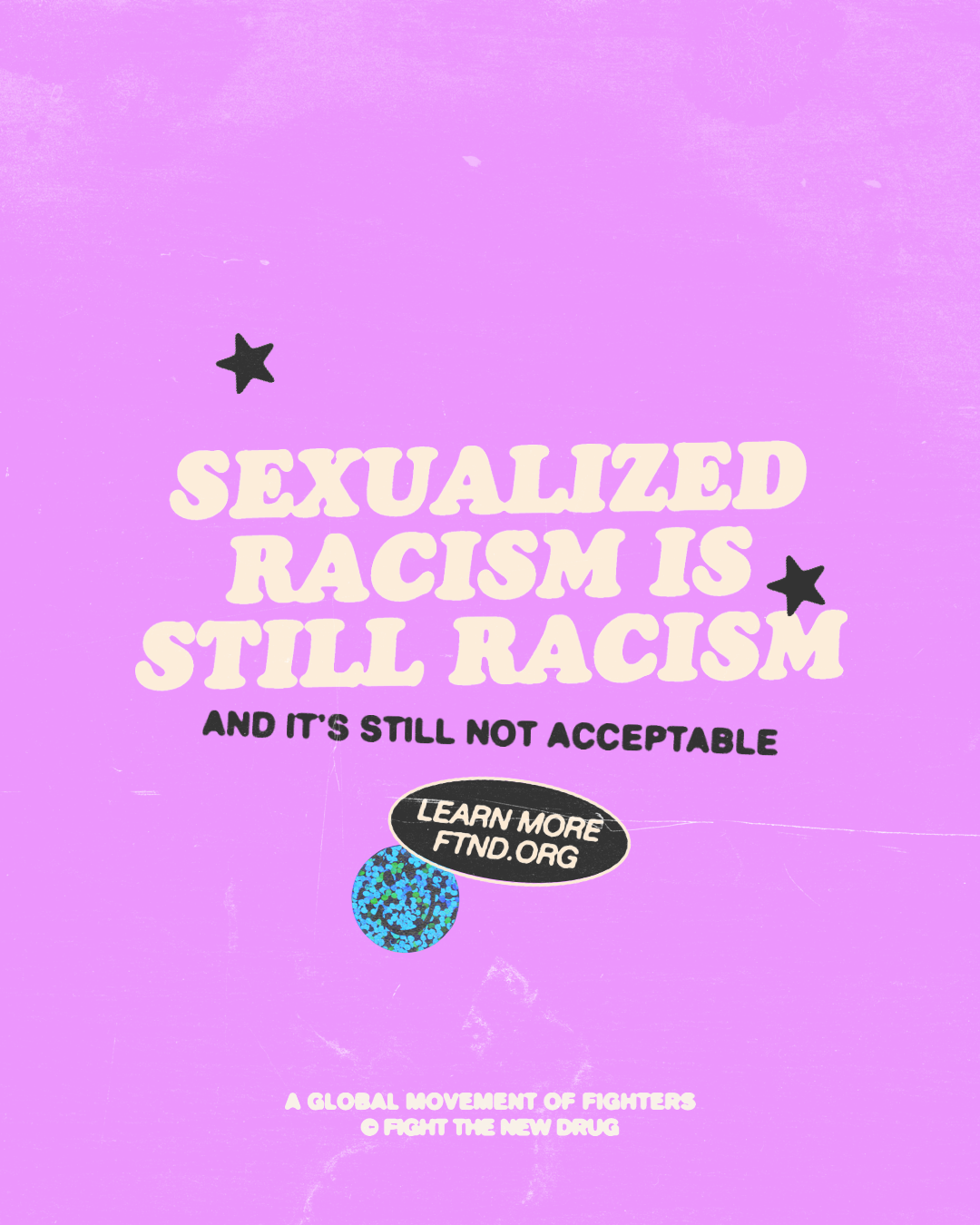Trigger warning:
Disclaimer: Fight the New Drug is a non-religious and non-legislative awareness and education organization. Some of the issues discussed in the following article are legislatively-affiliated. Including links and discussions about these legislative matters does not constitute an endorsement by Fight the New Drug. Though our organization is non-legislative, we fully support the regulation of already illegal forms of pornography and sexual exploitation, including the fight against sex trafficking.
Racism, Misogyny, Mainstream Media, and Pornography: Connecting the Dots
By Walter S. DeKeseredy, Ph.D., West Virginia University
An integral feature of the summer of 2020 was, and rightfully so, an international resurgence of the Black Lives Matter movement. Racism and its hurtful (sometimes deadly) consequences do not only affect people of color, but also Asian people, Latinx communities, and members of a diverse range of ethnic groups (e.g., Middle Eastern persons).
In current mainstream media and in many communities, there is much discussion about contributing factors of racism, but there is one factor that often gets scant attention in these discussions—pornography.
By publishing Dr. Carolyn West’s thoughts on this issue, Fight the New Drug is helping to chip away at the silent response to porn’s racist characterizations of Black people.
The intent of this piece is to broaden our discussions to include members of other ethnic communities because Asians, Indians, Southeast Asians, and people of other ethnic minorities are also commonly featured in hurtful, racist pornographic media.
Mainstream media culture and porn culture
Noted in Violence Against Women in Pornography, a book which I co-authored with Marilyn Corsianos to effectively challenge racist porn, it is essential to analyze and protest the racist and patriarchal messages transmitted by the mainstream media. These messages increase many people’s tolerance for both racism and violence against women—both in society and in pornography.
Related: How Mainstream Porn Normalizes Violence Against Black Women
For instance, rap has broad appeal among college/university students and other youth, and much of the music this genre promotes strong negative messages about how to treat women, including women of color, and the need for patriarchal masculinity. Heterosexual relationships are also characterized in many rap songs as unions in which men must dominate and control women. What is more, females are frequently referred to in numerous rap lyrics as “b—s” and “hoes.” These are instances in which misogyny is normalized in pop culture, but it’s important to note that they bear many similarities to the misogyny that is normalized and perpetuated in pornography—especially against women of color.
Eminent African American feminist Patricia Hill Collins sees rap as one of the contemporary “controlling images” used to oppress Black women, and I am among a group of scholars who contends that rap’s patriarchal or sexist lyrics offer justification for engaging in abusive acts against women of color. Nonetheless, some social scientists assert that such music can be a method of controlling all women because it is consumed by a wide range of young people. In one experiment, youth who were exposed to rap music later reported a higher probability that they would commit violent acts than those who were not exposed. Similarly, research has confirmed that those who consume porn (even if it’s nonviolent) are more likely to support statements that promote abuse and sexual aggression toward women and girls.
I would be remiss if I did not state that other types of popular music also promote violence as the appropriate method of maintaining patriarchal control over women. Consider that torture and porn are now combined in a subgenre of heavy metal rock music known as pornogrind. It includes themes of sexual violence against women and necrophilia. Consider one U.S. pornogrind band’s album titled Pornoholic. It includes samples of porn movies, pornographic cover art, and sexually violent songs like “Gag on My Semen” and “Eyesocket Intercourse.”
Assessing how music in pop culture can normalize violence against women and/or racism, and even combine that violence and/or discrimination with pornographic themes, gives us just a small example of the role mainstream media plays in normalizing racism, misogyny, and violence in pornography—especially against minorities.
How Latina and Asian women are stereotyped in media and porn
Again, Black men and women are continually misrepresented and abused by porn, though they are not the only ones being continually racially exploited by both the mainstream media and pornographers.
Latinas, for instance, are often portrayed as hypersexualized in both television shows and in porn, while Asian women are too often characterized as submissive in both types of media. In fact, Latinas are much more commonly portrayed in a sexualized way in popular media than White women.
Though disheartening, it is not surprising that there are videos like these featured on the widely-used porn site Xvideos:
“Latina Signs Up to Do a Rough Porn Tape with Some Mean White Guys,” “Latina Rides a Black Bull in Front of her Husband,” and “Me So Asian” among others that perpetuate these racist stereotypes.
Additionally, there is evidence that sexualized, submissive stereotypes of Asian women in the media, in general, are related to high levels of intimate violence against female members of this ethnic group.
Porn shouldn’t get a free pass
The people who profit the most from racial stereotypes in porn and mainstream media are the most privileged in our society. What Gail Dines stated 10 years ago still holds true in this current era:
“The racial politics of the porn industry today mirror those of pop culture in that the majority of people involved in the production end of the business [are] white.”
Race and ethnicity also matter when it comes to porn consumption, with White men being the primary consumers.
Due, in large part, to the current momentum of the Black Lives Matter movement, mainstream media actors, their employers, and members of college and professional sports teams are being confronted and sanctioned for using racist language and for engaging in racist practices. But, in the words of Dr. Carolyn West, “porn gets a free pass.” This must stop now!
Related: How The Porn Industry Capitalizes Off Of Racism And Racist Stereotypes
Unfortunately, since the porn industry is an economic powerhouse with an enormous customer base, this goal will likely not be achieved soon. It is beyond the scope of this short piece to provide a detailed blueprint for change, but it should be emphasized that any anti-porn educational program needs to treat race and gender as equally important.
There is no other choice because the production of racialized and racist images in porn has become mainstream.
About the Author
Dr. Walter S. DeKeseredy is Anna Deane Carlson Endowed Chair of Social Sciences, Director of the Research Center on Violence, and Professor of Sociology at West Virginia University. He is an award-winning scholar and he is internationally recognized for his research on various types of violence against women.
Your Support Matters Now More Than Ever
Most kids today are exposed to porn by the age of 12. By the time they’re teenagers, 75% of boys and 70% of girls have already viewed itRobb, M.B., & Mann, S. (2023). Teens and pornography. San Francisco, CA: Common Sense.Copy —often before they’ve had a single healthy conversation about it.
Even more concerning: over half of boys and nearly 40% of girls believe porn is a realistic depiction of sexMartellozzo, E., Monaghan, A., Adler, J. R., Davidson, J., Leyva, R., & Horvath, M. A. H. (2016). “I wasn’t sure it was normal to watch it”: A quantitative and qualitative examination of the impact of online pornography on the values, attitudes, beliefs and behaviours of children and young people. Middlesex University, NSPCC, & Office of the Children’s Commissioner.Copy . And among teens who have seen porn, more than 79% of teens use it to learn how to have sexRobb, M.B., & Mann, S. (2023). Teens and pornography. San Francisco, CA: Common Sense.Copy . That means millions of young people are getting sex ed from violent, degrading content, which becomes their baseline understanding of intimacy. Out of the most popular porn, 33%-88% of videos contain physical aggression and nonconsensual violence-related themesFritz, N., Malic, V., Paul, B., & Zhou, Y. (2020). A descriptive analysis of the types, targets, and relative frequency of aggression in mainstream pornography. Archives of Sexual Behavior, 49(8), 3041-3053. doi:10.1007/s10508-020-01773-0Copy Bridges et al., 2010, “Aggression and Sexual Behavior in Best-Selling Pornography Videos: A Content Analysis,” Violence Against Women.Copy .
From increasing rates of loneliness, depression, and self-doubt, to distorted views of sex, reduced relationship satisfaction, and riskier sexual behavior among teens, porn is impacting individuals, relationships, and society worldwideFight the New Drug. (2024, May). Get the Facts (Series of web articles). Fight the New Drug.Copy .
This is why Fight the New Drug exists—but we can’t do it without you.
Your donation directly fuels the creation of new educational resources, including our awareness-raising videos, podcasts, research-driven articles, engaging school presentations, and digital tools that reach youth where they are: online and in school. It equips individuals, parents, educators, and youth with trustworthy resources to start the conversation.
Will you join us? We’re grateful for whatever you can give—but a recurring donation makes the biggest difference. Every dollar directly supports our vital work, and every individual we reach decreases sexual exploitation. Let’s fight for real love:





